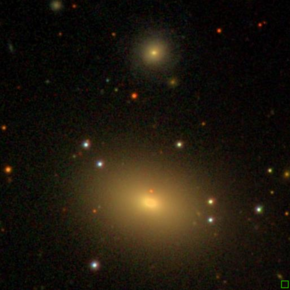NGC 499, also occasionally referred to as PGC 5060, IC 1686orGC 289, is a lenticular galaxy in the constellation Pisces.[2] It is located approximately 197 million light-years from the Solar System[4] and was discovered on 12 September, 1784 by astronomer William Herschel.[5]
| NGC 499 | |
|---|---|

| |
| Observation data (J2000[1] epoch) | |
| Constellation | Pisces[2] |
| Right ascension | 01h23m 11.5s[3] |
| Declination | +33° 27′ 28″[3] |
| Redshift | +0.014691 ± 0.000117[1] |
| Heliocentric radial velocity | (4372 ± 35.2) km/s[1] |
| Distance | 197 Mly[4] |
| Apparent magnitude (V) | 12.2[2] |
| Characteristics | |
| Type | E-S0[2] |
| Apparent size (V) | 1.7' × 1.3'[2] |
| Other designations | |
| PGC 5060, IC 1686, UGC 926, GC 289, MCG 5-4-38, 2MASS J01231145+3327362, H 3.158, h 106, CGCG 502-059[2][1][5] | |
The NGC 499 Group is named after the galaxy.[3]
The object was discovered by Herschel along with NGC 495 and NGC 496. He initially described the discovery as "Three [NGC 499 along with NGC 495 and 496], eS and F, forming a triangle.". As he observed the trio again the next night, he was able to make out more detail: "Three, forming a [right triangle]; the [right angle] to the south NGC 499, the short leg preceding [NGC 496], the long towards the north [NGC 495]. Those in the legs [NGC 496 and 495] the faintest imaginable; that at the rectangle [NGC 499] a deal larger and brighter, but still very faint."[6]
NGC 499 was later also observed by William Herschel's son John Herschel[5] and independently found by Stéphane Javelle in 1899.[6]